Sunday Poster Session
Category: Liver
P1302 - Don't Be Shocked! A Case of Fulminant Vibrio Vulnificus Septicemia in a Cirrhotic Patient
Sunday, October 27, 2024
3:30 PM - 7:00 PM ET
Location: Exhibit Hall E

Has Audio
- SS
Sangya Sharma, DO
University of South Alabama College of Medicine
Mobile, AL
Presenting Author(s)
Sangya Sharma, DO, Robert Ousley, MD, Mason G. Adams, MD
University of South Alabama College of Medicine, Mobile, AL
Introduction: Vibrio vulnificus is an opportunistic infection found in warm marine and brackish waters during the summer months, most commonly reported in the Gulf Coast states. Transmission occurs through skin exposure or consumption of undercooked or raw seafood. Risk factors include chronic liver disease, alcoholism, and hematological disorders. Fatality rates are higher in individuals with chronic liver disease and long-standing alcohol use. The disease can present as gastrointestinal tract infections, wound infections, and primary septicemia, the latter being the most common.
Case Description/Methods: We present the case of a 49-year-old female who presented with acute chest pain and bilateral lower extremity swelling of one week. Her past medical history was significant for alcoholic cirrhosis with active alcohol use. She was found to have high lactic acidosis and acute kidney injury, for which she received empiric antibiotics and intravenous fluids. Imaging was concerning for multi organ infarctions with wedge shaped renal hypoattenuations, diffuse colon wall thickening, and hypoattenuation of peripheral posteroinferior right hepatic lobe. Patient was admitted to the intensive care unit. Infectious workup revealed Vibrio vulnificus bacteremia from recent visit to the Gulf Coast and consumption of raw oysters. This infection was targeted with cefepime, doxycycline, and clindamycin. Despite supportive care, patient developed diffuse hemorrhagic bullae, worsening shock, and did not survive the infection.
Discussion: Infection with Vibrio vulnificus ranges from mild gastrointestinal symptoms to fulminant disease. Fulminant infection with Vibrio vulnificus carries high morbidity and mortality. Early diagnosis and initiation of targeted therapy within 24 hours of symptom onset have been shown to decrease mortality. Antibiotic therapy for severe infection consists of a third-generation cephalosporin and a tetracycline. Surgical debridement is important for patients with severe wounds. Educating patients with liver disease or other risk factors to take precautions in salt water and to avoid raw oysters is vital for preventing this infection.

Disclosures:
Sangya Sharma, DO, Robert Ousley, MD, Mason G. Adams, MD. P1302 - Don't Be Shocked! A Case of Fulminant Vibrio Vulnificus Septicemia in a Cirrhotic Patient, ACG 2024 Annual Scientific Meeting Abstracts. Philadelphia, PA: American College of Gastroenterology.
University of South Alabama College of Medicine, Mobile, AL
Introduction: Vibrio vulnificus is an opportunistic infection found in warm marine and brackish waters during the summer months, most commonly reported in the Gulf Coast states. Transmission occurs through skin exposure or consumption of undercooked or raw seafood. Risk factors include chronic liver disease, alcoholism, and hematological disorders. Fatality rates are higher in individuals with chronic liver disease and long-standing alcohol use. The disease can present as gastrointestinal tract infections, wound infections, and primary septicemia, the latter being the most common.
Case Description/Methods: We present the case of a 49-year-old female who presented with acute chest pain and bilateral lower extremity swelling of one week. Her past medical history was significant for alcoholic cirrhosis with active alcohol use. She was found to have high lactic acidosis and acute kidney injury, for which she received empiric antibiotics and intravenous fluids. Imaging was concerning for multi organ infarctions with wedge shaped renal hypoattenuations, diffuse colon wall thickening, and hypoattenuation of peripheral posteroinferior right hepatic lobe. Patient was admitted to the intensive care unit. Infectious workup revealed Vibrio vulnificus bacteremia from recent visit to the Gulf Coast and consumption of raw oysters. This infection was targeted with cefepime, doxycycline, and clindamycin. Despite supportive care, patient developed diffuse hemorrhagic bullae, worsening shock, and did not survive the infection.
Discussion: Infection with Vibrio vulnificus ranges from mild gastrointestinal symptoms to fulminant disease. Fulminant infection with Vibrio vulnificus carries high morbidity and mortality. Early diagnosis and initiation of targeted therapy within 24 hours of symptom onset have been shown to decrease mortality. Antibiotic therapy for severe infection consists of a third-generation cephalosporin and a tetracycline. Surgical debridement is important for patients with severe wounds. Educating patients with liver disease or other risk factors to take precautions in salt water and to avoid raw oysters is vital for preventing this infection.

Figure: Figure 1: bilateral lower extremity edema and lesions at onset of skin lesions
Figure 2: Hemorrhagic bullae in the upper left extremity in the intermediate stage of disease.
Figure 3: Ruptured hemorrhagic bullae in right lower extremity with surrounding necrosis and skin discoloration at the final stage of the disease.
Figure 2: Hemorrhagic bullae in the upper left extremity in the intermediate stage of disease.
Figure 3: Ruptured hemorrhagic bullae in right lower extremity with surrounding necrosis and skin discoloration at the final stage of the disease.
Disclosures:
Sangya Sharma indicated no relevant financial relationships.
Robert Ousley indicated no relevant financial relationships.
Mason Adams indicated no relevant financial relationships.
Sangya Sharma, DO, Robert Ousley, MD, Mason G. Adams, MD. P1302 - Don't Be Shocked! A Case of Fulminant Vibrio Vulnificus Septicemia in a Cirrhotic Patient, ACG 2024 Annual Scientific Meeting Abstracts. Philadelphia, PA: American College of Gastroenterology.
